At the heart of Italy’s Emilia-Romagna region, Bologna still waves its revolutionary flag. The “red city” resists the ones and zeros of tech culture for old fashioned human blood, sweat, and tears, often over bowls of its signature tortellini. In Bologna, organic isn’t just about food, it’s about living according to the natural rhythms of the people, much like the jazz music its citizens so love.
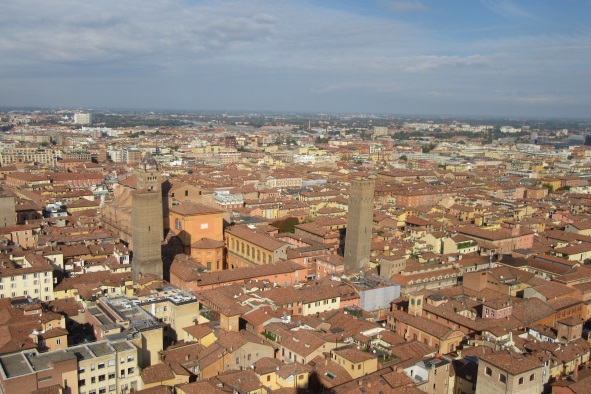
View of Bologna from Asinelli Tower (Photo: Mike Dunphy)
Jazz hit Bologna harder than most cities in Europe during its heyday in the 20th century. Something in the soul of the music fit like a glove to citizens of this city, and the greats of the day—Miles Davis, Chet Baker, Dizzy Gillespie, Duke Ellington, Ella Fitzgerald, Sarah Vaughan—obliged the love and became regular performers at the clubs on “La Strada Del Jazz.” In 1954, Italy’s first international jazz festival was established in Bologna, and just over fifty years later, in 2006, UNESCO made it official, declaring it a “City of Music.”
The source of jazz love may be in Bologna’s three nicknames: the fat, the red, and learned. In a certain slant of light, jazz does indeed reflect a similar strain of intellectualism, revolution, and epicurean indulgence. But the real reason has more to do with the fact that few lines go straight in Bologna, at least for very long. This is not a city that follows any systematic, central planning. Instead, the streets of the exquisitely preserved medieval core curve, turn, bisect, narrow, widen, and shoot off at tangents, before coming back on themselves (especially if you lack a map), just like a jazz jam.
Jazz and Urban Planning
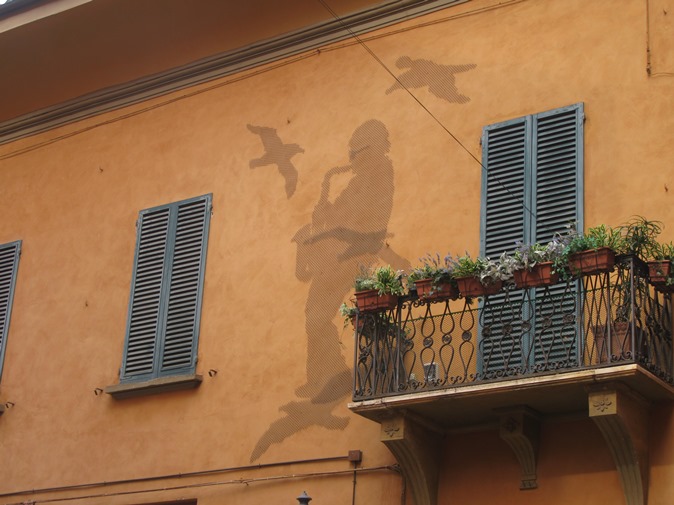
Bologna’s love of jazz in inscribed on the buildings (Photo: Mike Dunphy)
This “organic” approach to city development, according to the needs and movements of the people extends to everyday life in Bologna. Time here ticks not so much to the hands of the clocks but generations of human rhythm going back to pre-history.
A climb of the 319-foot Asinelli Tower that dominates the skyline, offers the best sense of this. Although students at the University of Bologna beware: Urban legend says you’ll never graduate if you go up before completing your degree. Built during 1109–19, it is a tight squeeze up the 498 tower steps and god is usually wheezingly praised upon reaching the top. But it’s worth the near loss of lung, as Bologna spreads out in beautiful terracotta for 360 degrees, stretching into a malformed heptagon, as delineated by the old city walls. The major boulevards show some systematic thought, but each is linked to dozens of lanes and alleys that run willy-nilly. It looks less like a grid, and more like a web spun by an intoxicated spider.
At the center is the Piazza Maggiore noted for its fountain, topped by a colossal 16th century bronze statue of Neptune, and the forever unfinished Duomo, half-faced in marble and the rest left in raw brick. Anyone looking to get the pulse of Bologna need only press two fingers on the stones here, where all parts of the city—tourist, expat, and local—come together to meet, perform, protest, and celebrate.
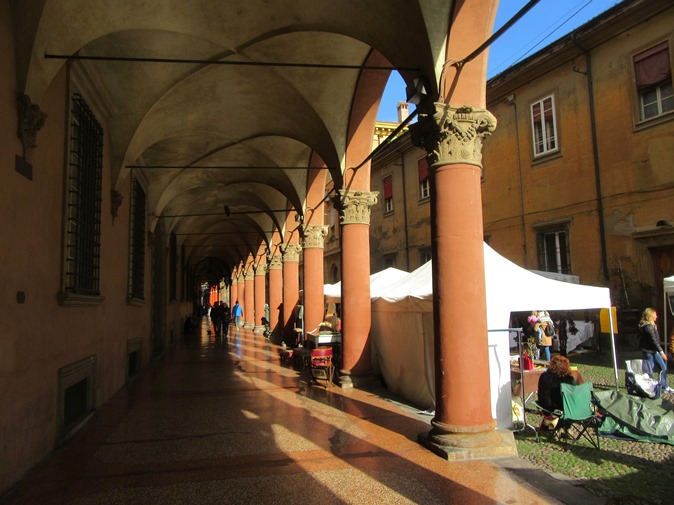
Porticoes cover 25 miles of sidewalks in Bologna (Photo: Mike Dunphy)
Sheltering them all from the elements are Bologna’s most visible and appreciated nod to its organic, human-centric approach: 25 miles of porticoed sidewalks offering near constant protection from wind, rain, sleet, snow, or sun. Most are in brick or stone, but the oldest remain propped up on ancient wooden beams. The most famous is at the Casa Isolani, a few blocks east (well, east-ish) of the main square. The three legendary arrows sticking from the bottom are the supposed result of a Renaissance assassination gone awry because of a naked woman.
Outspoken
Just to the north, along the Via Zamboni, the most outspoken elements of the organic spirit are heard from the students and faculty of the University of Bologna; the oldest higher education institute in Europe at nearly 1,000 years old. Take a seat in any of the eateries, pubs, cafes, and bookshops along the street and you’ll quickly apprehend the leftist spirit (and accompanying fashion statements). The students cut even looser after the sun goes down several blocks to the west, in the Pratello neighborhood, where few tourists go for lack of brick and mortar attractions.
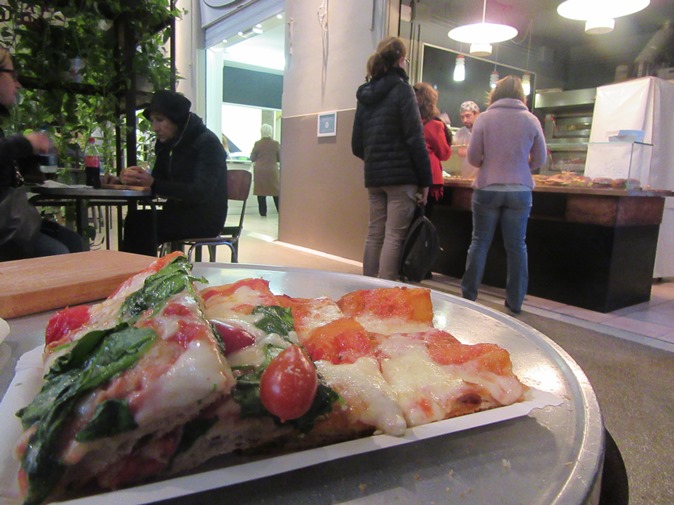
Fantastic pizza at Bologna’s Mercato Delle Erbe (Photo: Mike Dunphy)
On the way to Pratello, the modern sense of organic gets the spotlight at the Mercato Delle Erbe, Bologna’s oldest and largest covered market. Here the farmers of the fertile Emilia-Romagna region sell fruits, vegetables, meat, nuts, cheese, and more from the central kiosks, but most visitors prefer to spend their money in the two adjoining foot courts, where the bounty is turned into memorable pizzas, panini, pastas. It’s particularly fitting that the tortellini the city is so famous for was inspired by the human anatomy: The bellybutton of the infamous Renaissance beauty (and daughter of Pope Alexander VI) Lucrezia Borgia, so the legend goes.
But probably no better confluence of the people, land, and spirit can be found in Bologna than at Osteria del Sole, buried deep (and thanks to no sign, often unnoticed) in the tourist-heavy “quadrilateral” neighborhood adjacent to Piazza Maggiore. For 550 years, wine has flowed among the wide cross-section of Bolognese society that arrives every day, from artists and academics to bankers and barflies.
Like the bones and flesh of living organisms, the walls and crossbeams that prop up the wine bar sag and bow with age. The wine itself is forgettable, but the experience is not. The same could be said for the immediate aftermath of a thrilling jazz odyssey, which leaves both player and audience in ecstasy but unable to remember or repeat the notes.
That’s because in Bologna, resistance to the Man includes the machine. What drives the city is not steam, coal, gas, wind, or solar, but human energy.
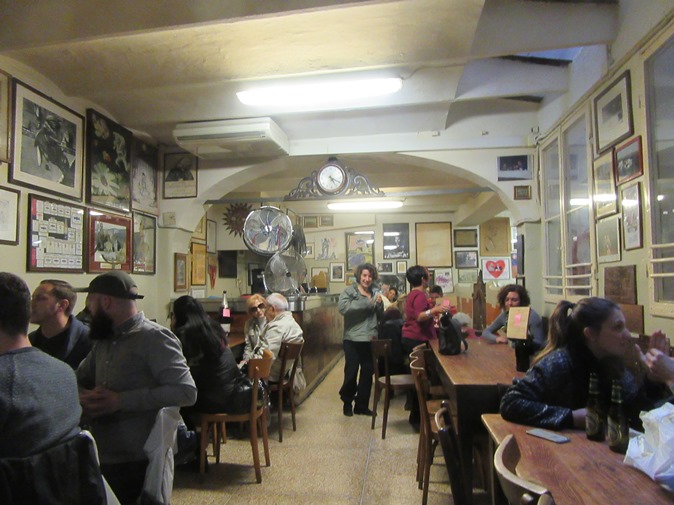
Osteria del Sole has been pouring wine for 550 years (Photo: Mike Dunphy)
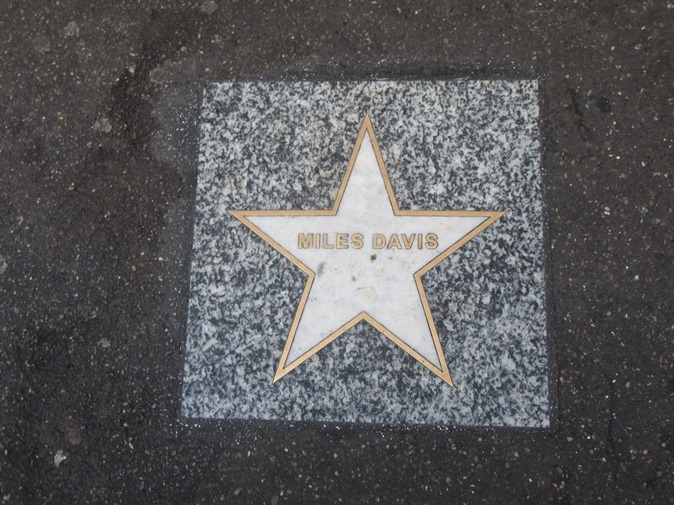
Miles Davis and other jazz legends get tribute on La Strada Del Jazz (Photo: Mike Dunphy)